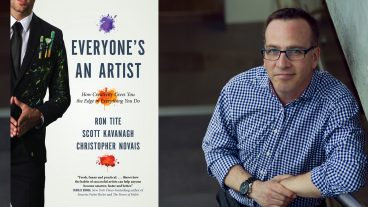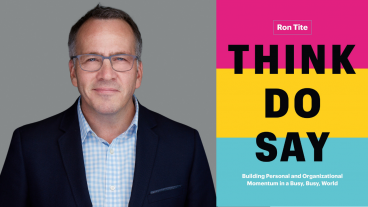A facilitator stands at the front of the room before a group of melancholy middle managers who have signed up for training because, among other things, it shows that they’re committed to personal development. After the muffins have been grabbed, the coffee has been poured, and the whirring projector has been focused, the facilitator steps forward, leans into the room, and presents their opening query — “So, what IS creativity?”
As a founder of a creative agency, a former executive creative director, and the co-author of a book that is literally called, Everyone’s an Artist, any attempt to provide a singular definition for creativity gives me a rash. To a junior art director, creativity might mean the desire to create a reaction. To a global CMO, creativity might mean the desire to create disruption. To an interpretive dancer struggling to pay rent, creativity might mean the desire to fulfill a life’s purpose. There are enough TED talks on creativity and Maya Angelou-inspired Instagram quotes on creativity without me trotting out one more.
But I’ll tell you what creativity isn’t: Predictable.
Oil Meet Water
Creativity is based in original thought and expression. Creativity defies logic, presents unique perspectives, and results in people thinking, “Wow. That is so unexpected.” Predictability, on the other hand, channels logic, presents repurposed perspectives, and results in people thinking, “Yup. Just as I expected.”
Let’s face it. Creativity and predictability can’t work together. They could never co-exist. And the only place they should be seen side-by-side is in a branded content Youtube renewal of the sitcom, The Odd Couple.
Clients routinely brief their agencies with, “Show me something that has never been done before. And be sure to include some benchmarks on performance.” Sorry, but that’s not how logic works. If something is so creative that it has never been thought of, forecasting reaction is not only impossible, it’s irresponsible.
But I get it.
Yes, our brands need to have a soul so we can elevate the conversation, put purpose before product, and connect in meaningful and compelling ways. We need original thinking and never-before-seen ideas that make people stop, look, and listen.
But you can’t swing for the fences without being comfortable that you might strike out. And striking out just isn’t something most organizations are comfortable with. While CEOs can deliver the proverbial, “We need to embrace failure” speech, there is nothing about corporate culture that embraces failure. You’re not encouraged to fail. You’re not compensated to fail. You’re paid to make forecasts, then meeting (or slightly exceeding) them.
No Risk, No Reward, No problem
In a recent discussion with Seth Godin, I asked him why marketers choose the safe and predictable route by chasing certain data-centric tactics and the benchmarked metrics they provide. His response: “I don’t think people are lazy, as much as they are afraid.”
I agree with him. To use his words, predictability gets you “off the hook”. No risk means no surprises. No surprises mean no failures. No failures mean you get to continue feeding your family.
But wait, there’s more.
Be a Rock
When Chris Rock performs a televised or Netflixed (?) comedy special, you may laugh at the hilarity and bow down in front of his brilliance. But Rock, (or any other professional comedian worth discussing), is more about predictability than they are about creativity. Behind the hour we see are hundreds of hours on the road perfecting the material so that by the time he records it, every line, every beat, every expression, and every step is delivered in the best way possible. Creativity may be at the heart of it, but the creativity becomes predictable.
Creativity isn’t killed by predictability. It becomes it. Every artist knows you make more money from the print than you do from the original. It’s just that the most successful prints come from the most brilliant and unique originals.
But how do you do it? How do you use unbridled creativity to lead you to predictable levels of elevated performance? Do you use one of those stock shots of the two sides of the brain? Do you train your creatives to use a spreadsheet? Do you trade in the denim for khakis?
No. You get a Flint.
Turn Your White Collar into a Blue Collar.
I grew up in Oshawa, Ontario so my natural inclination is to use the “Shwaw” to reference General Motors but given the state of automobile manufacturing in the city that once “moto-vated Canada”, Flint, Michigan is probably more appropriate.
See, GM and other car manufacturers can teach us a lot about how creativity can lead to predictability. Marketers need to adopt the two sides to their manufacturing process.
1. The assembly line
The assembly line is where the car folks make their money. Every single ounce of inefficiency has been removed from the assembly line. Everyone on the team has a role that is very clearly defined. Whatever they do, they do it over and over and over. It’s not only efficient, it’s repeatable behaviour. The result is that quality is maintained, costs are contained, and the margin is consistent. Every. Single. Time.
Interestingly, there’s no collaboration on the assembly line. Nobody halts production to blue sky or spit-ball some crazy idea. Everyone does their job, they pass it off to the next person, and the line continues with peak efficiency. They have benchmarks for production, forecasts on costs, expected rates of return, clear ROI, and a commitment to quality control.
While they’re doing that, many marketers and their agency partners are arguing over the colour of the napkin in the background of a photo of a bowl of soup, drawing out the process by over-analyzing details that have little significance to the overall results.
If it’s assembly line, it’s assembly line. Kill it and bill it. Deliver it in the most efficient way possible and move on so you can save time, money, and brain power on the stuff that will really rock your world. And while you’re at it, remember that the original HP Way, “Management by Walking Around” has been replaced by “Management by Reply All”. You can bet far more efficient in how you personally work, too.
2. The concept car
When automotive manufacturers want to explore new ideas to topple their own established ways of thinking, they create a concept car. The concept car is off the assembly line. There’s no hope or expectation that the concept car will ever go into production. They just do it to do it.
Sometimes, they’ll discover that one component of the concept car can be integrated into the assembly line. Over time, the assembly line innovates responsibly because of the experimental components that feed it.
The predictable assembly line is where you meet your forecasts, improve your ROI, establish benchmarks, and engage in repeatable behaviour that delivers the metrics you cherish.
The concept car is where you remove the handcuffs to play, try things you’ve never done before, integrate new and original perspectives, and create art.
The concept car is where you spend your money. The assembly line is where you make it.
Most start-ups are just building concept cars. Most established organizations are just assembly lines. The best type of organization is the one that can have a healthy balance of the two. remember, they’re an odd couple. They don’t exist together. One becomes the other.
Some additional thoughts to consider:
1. Choose carefully.
With intense pressure to innovate, many marketers are trying to build multiple concept cars in the middle of the assembly line. (Launch a hashtag challenge on TikTok! Produce a podcast! Recruit influencers!!!) The result is chaos. No one is exactly sure what they’re supposed to do or how their success will be evaluated, and morale craters over the uncertainty. There’s no repeatable behaviour, so quality goes down, costs go up, and margin is eroded. The result is that the skeptics take a look at the numbers and grumble, “I told you we should have just done it the old way.”
2. Let brilliance bubble to the top.
In a discussion on harnessing great ideas, a global tech CEO I was with pointed out the difficulty of developing concept cars for established organizations and why start-ups seem to be disrupting the predictable-craving established organizations. When a start-up has a great idea, they can pitch twenty VCs in a row, getting a “no” every time. But if the twenty-first VC says yes, they can go to market. Within large organizations, if someone has a great idea, they have to pitch the idea up a long line of bosses and get a “yes” every single time. The first “no” they encounter kills the idea. Great ideas and creative brilliance need to bubble to the top.
3. Don’t embrace failure.
I don’t love the phrase “embrace failure” because there are times when we should definitely not embrace failure. At no point should you embrace failure on the assembly line. There is no room for failure there. And put another way, creative concept cars are experiments. Experiments, by their very nature, can’t fail. They only fail when we marketers arbitrarily place unrealistic benchmarks for them to meet.
On the topic of embracing failure, one CEO of a global e-commerce company I was at an event with called it a myth. He said, “As an example, we’ve built 85 distribution centres. We should know how to do that by now. The only place you should embrace failure is in experiments. But if you define an experiment as a failure, I don’t think you understand what experiments are supposed to do.”
4. Don’t forget to invest in the assembly line.
On a global basis, Coca-Cola spends about 70% of its marketing dollars on assembly line activities — tactics that meet desired and expected levels of performance. But importantly, 20% of their budget is allocated to improving the assembly line and increasing its efficiency. Process improvement can deliver work faster. Technology adoption can streamline how you share information. A data ecosystem can customize and personalize creativity for greater impact and better returns. Training and development can help make people smarter and more confident in their abilities. And apparently, an axe-throwing party with your agency partners can lead to greater understanding and quicker approvals. Regardless how you do it, increasing the efficiency of the assembly line leads to more money, more time, and more energy to create mind-blowing work that will grow your business and build your career.
Look, a simple automotive metaphor may lead to greater understanding but please don’t think there’s anything simple about its implementation. You’re a marketer. Maybe you’re the data driven, analytical marketer who loves crunching numbers, and driving engagement within two decimals places of your prediction. Maybe you’re the artistic brand champion grounded in the soul and desired emotional response of your communications. Crossing over isn’t easy. Just put one foot in front of the other.
Creative becomes predictable.
Creative becomes predictable.
Creative becomes predictable.
Ron Tite originally wrote this article as a complement to his keynote for our client, Canada Post. It appeared in both the digital and print issue of their magazine, Incite. Our speakers can often go above and beyond their talk to add value for our clients and their event attendees, including articles, meet & greets, book signings, etc. When booking your next speaker, ask us what we can do to make the experience even better for you!
Addressing a variety of topics surrounding branding, corporate strategy, creativity, content, and social media, Ron’s presentations are not only information-packed, they’re also infused with his unique humour — guaranteed to have you laughing while you learn.
Named one of the “Top 10 Creative Canadians” by Marketing Magazine, Ron’s been an award-winning advertising writer and creative director for some of the world’s most respected brands, including Air France, Evian, Hershey, Johnson & Johnson, Kraft, Intel, Microsoft, and Volvo.
Interested in learning more about Ron and what he can bring to your next event? Email us at [email protected].




